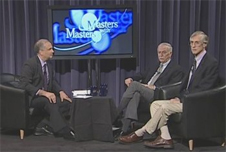November 24, 2009 Vol. 2, Issue 11
The Academy’s second Masters with Masters event featured Dr. John Mather and Dennis McCarthy, who shared critical learning experiences related to the Cosmic Background Explorer, the James Webb Space Telescope, and other complex science projects.
John Mather and Dennis McCarthy sat down with the Academy’s Ed Hoffman in the NASA Auditorium on October 28, 2009 to share stories about leadership, perseverance, learning from mentors, and finding the right team. The discussion focused largely on their work together on the Cosmic Background Explorer (COBE), a project with ambitious goals, and cutting-edge technology and science. Mather was the COBE Project Scientist and Principal Investigator for the Far Infrared Absolute Spectrophotometer (FIRAS) instrument, and McCarthy was the Deputy Project Manager. The groundbreaking science from COBE led to a 2006 Nobel Prize in Physics for Mather and Dr. George Smoot of the University of California/Berkeley.

Ed Hoffman (left), Dennis McCarthy (center), and John Mather (right) discuss their critical learning experiences at the second Masters with Masters. Image Credit: Masters with Masters
A familiar hurdle they had to deal with was communication across the engineering and science disciplines. Mather is a scientist by training, and McCarthy is an engineer. The technology for the project was so advanced at the time that communicating requirements to build the spacecraft proved particularly challenging. “The scientists are likely to say, ‘Well, if it’s not impossible, then let’s do it,'” explained Mather, “The engineer has to say, ‘Well, I heard you, but I don’t know how to do that. How are we going to do this?'”
Ultimately, it took a lot of patience, Mather said. “A lot of engineers were pretty annoyed with the scientists for a while because we couldn’t tell them what we needed,” explained Mather, “but this really was a territory where nobody has been before and we sort of had to work together to explore that territory.”
Mather and McCarthy worked together on the COBE spacecraft for over seven years, meeting once a week for a private lunch to discuss the project. With the ever-present issue of requirements — or lack thereof — and testing the spacecraft, McCarthy knew that they would have to test what they could and wait to see if it worked.
“Test, test, test,” said McCarthy. “We would defer a test,” said McCarthy, who actually deferred testing for two weeks on the instrument that would ultimately win Mather the Nobel Prize, “but we would never eliminate it. You cannot stand up at the end of the program and say it’s ready unless you have tested it.”
Mather learned his lesson about testing early on in his career. While working on his thesis project, a balloon instrument, he recalls the trouble caused by cold weather. His team had grown tired of testing and his thesis project — a precursor to his instrument on COBE — ultimately failed. Mather learned his lesson, “Testing is tiresome, tedious, boring, and essential,” he said, “If you do not test it, it will not work.” (Mather also remembers thinking that he’d never work on this cosmic background radiation business again. “But NASA did change my mind,” said Mather. “You never know what’s going to happen.”)
Assembling the right team was central to COBE’s success. “People are the ones who make the project happen,” said Mather. “We didn’t have to go out and say, ‘This is a great project.’ They (other NASA employees) heard from their friends that this was a great project, and that this was the thing to be on if you could be,” he said. “There’s a kind of context that can be created, which attracts the talent that you need.”
The NASA TV video of this Masters with Masters event will be posted on the APPEL Multimedia page in early December 2009.
Watch video clips of the first event with NASA Associate Administrator Chris Scolese and NASA Chief Engineer Mike Ryschkewitsch.
Read Lessons from COBE About Processes and Procedures by Dennis McCarthy





